184. A winter wonderland at Tsarskoye Selo
I decided to return to Tsarskoye Selo on a weekend in the middle of December. It is my favorite of St. Petersburg's suburbs and I did not have enough time to explore all of Catherine Park and Alexandrovsky Park the last time I was there (I visited in July mostly to tour Catherine Palace and see an opera production on the parade grounds). The two parks - the former to the south of the palace and the latter to the northwest of the palace - both contain numerous bridges, gates, columns, and follies. Most of the buildings scattered throughout the parks are closed to visitors during the winter months, but are still quite interesting to see from the outside. And, with the first snowfalls accumulating in late November and early December - and temperatures remaining below 3 or 4 degrees Celsius (upper 30s Fahrenheit) during that time - a nice blanket of snow gave the parks a magical aura.
I spent most of my time in Catherine Park, and walked around the Great Pond (almost completely frozen over) to see all the features that surround the lake. The gardens and their buildings were designed and constructed throughout the eighteenth and nineteenth centuries, with significant reconstruction work taking place in the second half of the twentieth century (and continuing today). Highlights on the east side of the park include two Baroque buildings: the Grotto Pavilion (built in 1749-1761) and the Hermitage Pavilion (1749-1754), both designed by Bartolomeo Francesco Rastrelli. The main feature on an island in the middle of the lake is the Chesme Column, erected in 1774-1776 in honor of Russia's victory in the Russo-Turkish War of 1768-1774 (just like the Chesme Church in St. Petersburg).
On the west side of the water, the Turkish Bath Pavilion (1850-1852) and the three buildings of the Admiralty Pavilion (1773-1777) impressed me the most. The Marble Bridge (1772-1774) is also a spectacular feature on this side of the park. Highlights in Alexandrovsky Park to the north of the palace include the Dragon Bridge (1785), Cross Bridge (1776-1779), and the Arsenal Pavilion (1817-1834). Throughout my walk, I also enjoyed views of the snow-covered Catherine Palace from a variety of vantage points, even if most of the marble statues outside the palace and throughout the park had been boxed up in October or November for added protection from the elements during the winter.
The two parks cover a combined 300 hectares, and it would take several days to explore all their nooks and crannies. I spent all afternoon exploring the area, but I still missed several dozen of the features. It amazes me the amount of wealth and leisure time Russia's emperors and empresses must have had in order to justify (and afford) all these projects - and why all these pavilions were even considered necessary with such a spectacular palace a short walk away! Regardless, these parks are an amazing setting and a great place to enjoy the winter landscape. Everyone in St. Petersburg is clearly in agreement: hundreds of couples and families were out enjoying the parks the afternoon I was there, building snowmen, pulling their children around on sleds, and just walking around enjoying the beauty of the natural and built environments.
Catherine Palace:
Southeast of Catherine Palace, in Catherine Park:
The Grotto Pavilion:
Winter scenery in the park:
The Hermitage Pavilion:
The Hermitage Pavilion Kitchen:
The Morea Column:
The Great Pond:
The Admiralty:
Chesme Column:
Turkish Bath Pavilion:
The Marble Bridge:
Pyramid Pavilion:
The Turkish Cascade:
The Ruin Tower:
The Oryol Gate:
Sledding in the park:
Granite Terrace:
Catherine Palace:
Northwest of Catherine Palace, in Alexandrovsky Park:
Chinese Theater:
Dragon Bridge:
The Arsenal Pavilion:
Cross Bridge:
Catherine Palace:
I spent most of my time in Catherine Park, and walked around the Great Pond (almost completely frozen over) to see all the features that surround the lake. The gardens and their buildings were designed and constructed throughout the eighteenth and nineteenth centuries, with significant reconstruction work taking place in the second half of the twentieth century (and continuing today). Highlights on the east side of the park include two Baroque buildings: the Grotto Pavilion (built in 1749-1761) and the Hermitage Pavilion (1749-1754), both designed by Bartolomeo Francesco Rastrelli. The main feature on an island in the middle of the lake is the Chesme Column, erected in 1774-1776 in honor of Russia's victory in the Russo-Turkish War of 1768-1774 (just like the Chesme Church in St. Petersburg).
On the west side of the water, the Turkish Bath Pavilion (1850-1852) and the three buildings of the Admiralty Pavilion (1773-1777) impressed me the most. The Marble Bridge (1772-1774) is also a spectacular feature on this side of the park. Highlights in Alexandrovsky Park to the north of the palace include the Dragon Bridge (1785), Cross Bridge (1776-1779), and the Arsenal Pavilion (1817-1834). Throughout my walk, I also enjoyed views of the snow-covered Catherine Palace from a variety of vantage points, even if most of the marble statues outside the palace and throughout the park had been boxed up in October or November for added protection from the elements during the winter.
The two parks cover a combined 300 hectares, and it would take several days to explore all their nooks and crannies. I spent all afternoon exploring the area, but I still missed several dozen of the features. It amazes me the amount of wealth and leisure time Russia's emperors and empresses must have had in order to justify (and afford) all these projects - and why all these pavilions were even considered necessary with such a spectacular palace a short walk away! Regardless, these parks are an amazing setting and a great place to enjoy the winter landscape. Everyone in St. Petersburg is clearly in agreement: hundreds of couples and families were out enjoying the parks the afternoon I was there, building snowmen, pulling their children around on sleds, and just walking around enjoying the beauty of the natural and built environments.
Catherine Palace:
Southeast of Catherine Palace, in Catherine Park:
The Grotto Pavilion:
Winter scenery in the park:
The Hermitage Pavilion:
The Hermitage Pavilion Kitchen:
The Morea Column:
The Great Pond:
The Admiralty:
Chesme Column:
Turkish Bath Pavilion:
The Marble Bridge:
Pyramid Pavilion:
The Turkish Cascade:
The Ruin Tower:
The Oryol Gate:
Sledding in the park:
Granite Terrace:
Catherine Palace:
Northwest of Catherine Palace, in Alexandrovsky Park:
Chinese Theater:
Dragon Bridge:
The Arsenal Pavilion:
Cross Bridge:
Catherine Palace:

























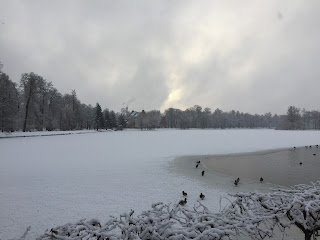




















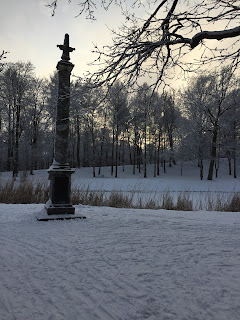


























































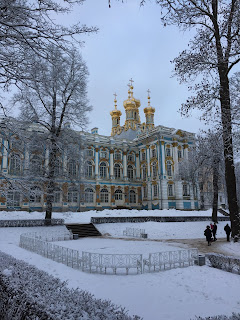
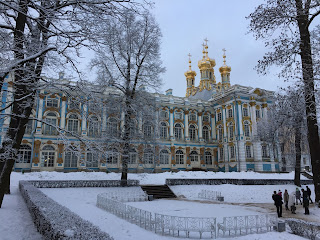






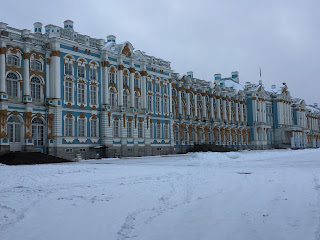








































Comments
Post a Comment